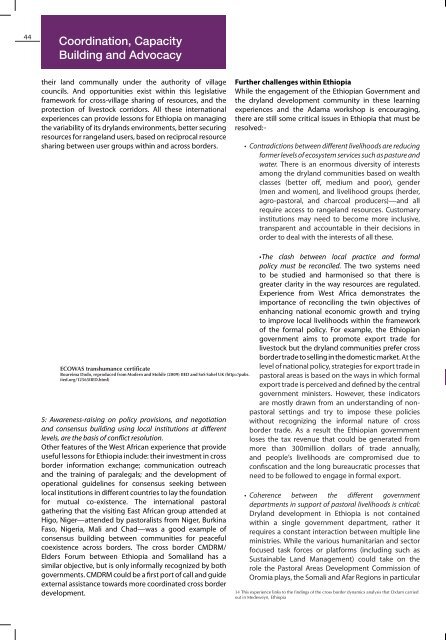Download PDF - ReliefWeb
Download PDF - ReliefWeb
Download PDF - ReliefWeb
- No tags were found...
You also want an ePaper? Increase the reach of your titles
YUMPU automatically turns print PDFs into web optimized ePapers that Google loves.
44 45Coordination, CapacityBuilding and AdvocacyResearchtheir land communally under the authority of villagecouncils. And opportunities exist within this legislativeframework for cross-village sharing of resources, and theprotection of livestock corridors. All these internationalexperiences can provide lessons for Ethiopia on managingthe variability of its drylands environments, better securingresources for rangeland users, based on reciprocal resourcesharing between user groups within and across borders.ECOWAS transhumance certificateBoureima Dodo, reproduced from Modern and Mobile (2009) IIED and SoS Sahel UK (http://pubs.iied.org/12565IIED.html)5: Awareness-raising on policy provisions, and negotiationand consensus building using local institutions at differentlevels, are the basis of conflict resolution.Other features of the West African experience that provideuseful lessons for Ethiopia include: their investment in crossborder information exchange; communication outreachand the training of paralegals; and the development ofoperational guidelines for consensus seeking betweenlocal institutions in different countries to lay the foundationfor mutual co-existence. The international pastoralgathering that the visiting East African group attended atHigo, Niger—attended by pastoralists from Niger, BurkinaFaso, Nigeria, Mali and Chad—was a good example ofconsensus building between communities for peacefulcoexistence across borders. The cross border CMDRM/Elders Forum between Ethiopia and Somaliland has asimilar objective, but is only informally recognized by bothgovernments. CMDRM could be a first port of call and guideexternal assistance towards more coordinated cross borderdevelopment.Further challenges within EthiopiaWhile the engagement of the Ethiopian Government andthe dryland development community in these learningexperiences and the Adama workshop is encouraging,there are still some critical issues in Ethiopia that must beresolved: 34• Contradictions between different livelihoods are reducingformer levels of ecosystem services such as pasture andwater. There is an enormous diversity of interestsamong the dryland communities based on wealthclasses (better off, medium and poor), gender(men and women), and livelihood groups (herder,agro-pastoral, and charcoal producers)—and allrequire access to rangeland resources. Customaryinstitutions may need to become more inclusive,transparent and accountable in their decisions inorder to deal with the interests of all these.• The clash between local practice and formalpolicy must be reconciled. The two systems needto be studied and harmonised so that there isgreater clarity in the way resources are regulated.Experience from West Africa demonstrates theimportance of reconciling the twin objectives ofenhancing national economic growth and tryingto improve local livelihoods within the frameworkof the formal policy. For example, the Ethiopiangovernment aims to promote export trade forlivestock but the dryland communities prefer crossborder trade to selling in the domestic market. At thelevel of national policy, strategies for export trade inpastoral areas is based on the ways in which formalexport trade is perceived and defined by the centralgovernment ministers. However, these indicatorsare mostly drawn from an understanding of nonpastoralsettings and try to impose these policieswithout recognizing the informal nature of crossborder trade. As a result the Ethiopian governmentloses the tax revenue that could be generated frommore than 300million dollars of trade annually,and people’s livelihoods are compromised due toconfiscation and the long bureaucratic processes thatneed to be followed to engage in formal export.• Coherence between the different governmentdepartments in support of pastoral livelihoods is critical:Dryland development in Ethiopia is not containedwithin a single government department, rather itrequires a constant interaction between multiple lineministries. While the various humanitarian and sectorfocused task forces or platforms (including such asSustainable Land Management) could take on therole the Pastoral Areas Development Commission ofOromia plays, the Somali and Afar Regions in particular34 This experience links to the findings of the cross border dynamics analysis that Oxfam carriedout in Medeweyn, Ethiopiamay need an innovative coordinating body that bringstogether the various bureaus supporting pastoralistsin line with their priorities and aspirations. (Currentlya Pastoralist Working Group is being established aspart of the RED&FS Agriculture Growth TechnicalCommittee in the Ministry of Agriculture. This couldprovide a new opportunity for doing this.)• Cross border interaction carries risk unless there is crossborder risk management: Often communities’ resilienceto drought is linked to their ability to move acrossborders and secure resources. However cross bordermobility in its current form carries a number of risksthat compound the consequences of drought—such as livestock diseases. Government and nongovernmentalorganization’s interventions can reducerisks when essential services are coordinated across theborder, and community institutions are strengthenedto negotiate their use.ConclusionsEthiopia’s regional pastoral land use policies still needto be fully developed but opportunities now exist toimprove them. Currently Afar’s policy and a draft SomaliPastoral Land Legislation already exist. Dialogue on thesereforms, based on experiences gained from West Africaand elsewhere, is now needed to strengthen the legalprovision, such as those related to aligning local practiceswith the legal framework. A broad based dialogue withkey stakeholders, such as community representatives fromdifferent livelihood groups, local and regional bureauPeuhl walking the animalsheads and ministries such as Ministry of Federal Affairsand Ministry of Rural Development, is required to bring allactors together on the same page.Cross border programmes need to be promoted urgently. Anumber of cross border programmes exist with the capacityto create incentives, including Oxfam GB’s Ethiopia andSomaliland cross border Community Managed DroughtResilience Project. These projects are piloting a number ofinnovations that could encourage national governmentsto implement reforms. For example, a recent preventivelivestock vaccination campaign in the Somali region ofEthiopia has been synchronized with one in Somaliland,where more than 14 million shoats are found. There are alsoexamples of cross-border landscape level planning bothwithin and across ecological zones.Experience from West Africa helps highlight the potentialand challenges ahead for Ethiopia. The way forwardlies in Ethiopia linking together the four themes in acoherent manner: rangeland management, livestockservices, mobility and legislation. The contradictionsbetween local practices and policy context, the interactionbetween different government departments, and the risksassociated with unregulated cross border mobility, are allkey challenges. But in the final analysis providing adequatesecurity of tenure and alternative livelihoods will be acondition for, and a means of achieving, disaster resilience.For further information please contact: abekele@oxfam.org.ukGlenn Edwards/Oxfam
















